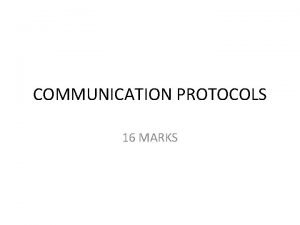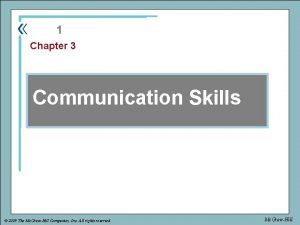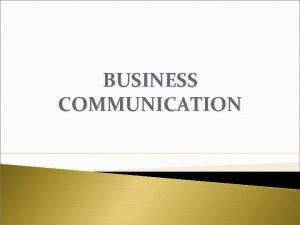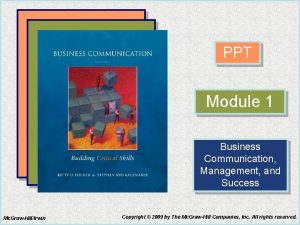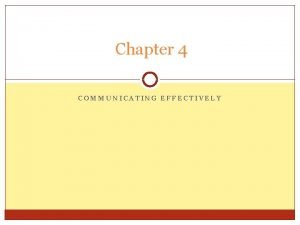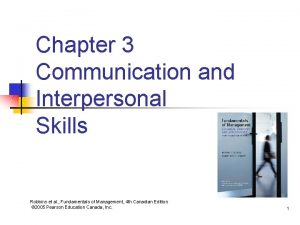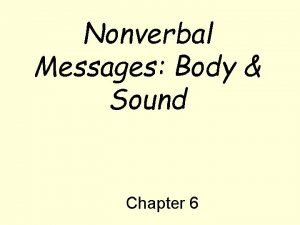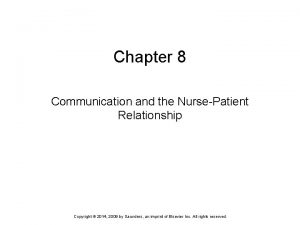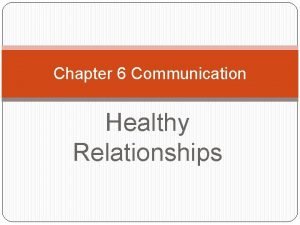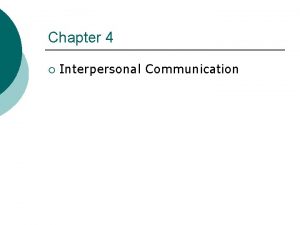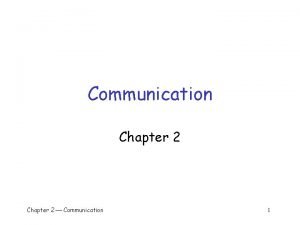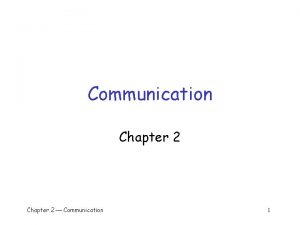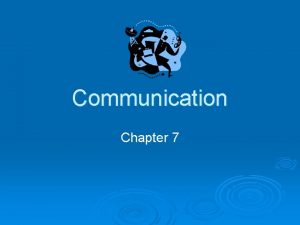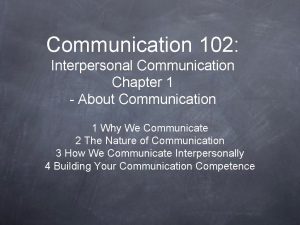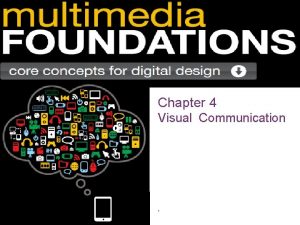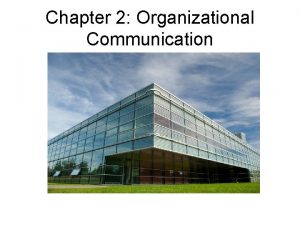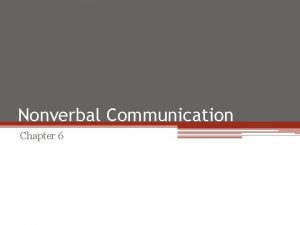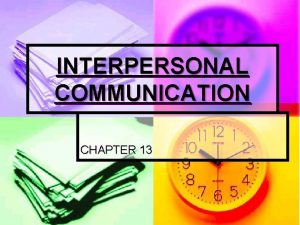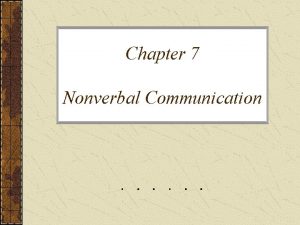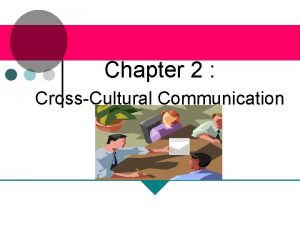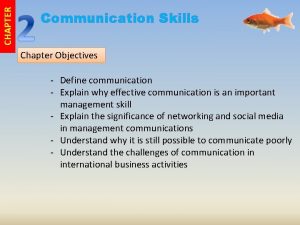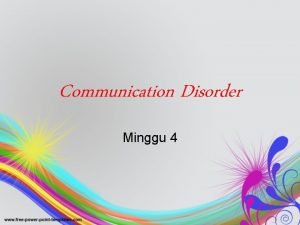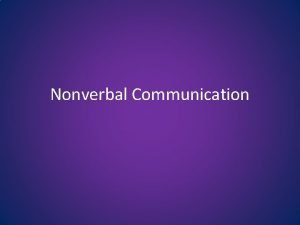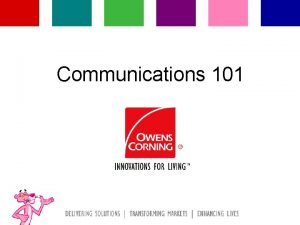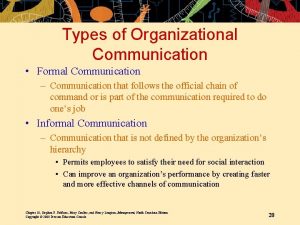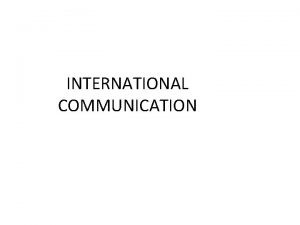Chapter 16 Communication 1 What Is Communication Communication

























- Slides: 25

Chapter 16 Communication 1

What Is Communication? • Communication – The transfer and understanding of meaning – Interpersonal communication • Communication between two or more people – Organizational communication • All the patterns, network, and systems of communications within an organization 2

Functions of Communication • • Control Motivation Emotional Expression Information 3

Interpersonal Communication • Message – Source: sender’s intended meaning • Encoding – The message converted to symbolic form • Channel – The medium through which the message travels • Decoding – The receiver’s retranslation of the message • Noise – Disturbances that interfere with communications 4

Exhibit 10. 1 The Interpersonal Communication Process Message Channel Decoding Encoding Sender Receiver Noise Message Feedback 5

Evaluating Communication Methods • • • Feedback Complexity capacity Breadth potential Confidentiality Encoding ease Decoding ease • Time-space constraint • Cost • Interpersonal warmth • Formality • Scanability • Time of consumption 6

Fitting Communication with Circumstances Managers can use 12 questions to help them evaluate appropriate communication methods for different circumstances. 1. Feedback. How quickly can the receiver respond to the message? 2. Complexity capacity. Can the method effectively process complex messages? 3. Breadth potential. How many different messages can be transmitted using this method? 4. Confidentiality. Can communicators be reasonably sure their messages are received only by those for whom they’re intended? 5. Encoding ease. Can the sender easily and quickly use this channel? 7

Fitting Communication with Circumstances (cont’d) 6. Decoding ease. Can the receiver easily and quickly decode messages? 7. Time–space constraint. Do senders and receivers need to communicate at the same time and in the same space? 8. Cost. How much does it cost to use this method? 9. Interpersonal warmth. How well does this method convey interpersonal warmth? 10. Formality. Does this method have the needed amount of formality? 11. Scanability. Does this method allow the message to be easily browsed or scanned for relevant information? 12. Time of consumption. Does the sender or receiver exercise the most control over when the message is dealt with? 8

Interpersonal Communication Methods • • Face-to-face Telephone Group meetings Formal presentations Memos Postal mail Fax Publications • • Bulletin boards Audio-/videotapes Hot lines E-mail Computer conference Voice mail Teleconference Videoconference 9

The Johari Window Communication Model Chapter 10, Stephen P. Robbins, Mary Coulter, and Nancy Langton, Management, Eighth Canadian Edition. Copyright © 2005 Pearson Education Canada Inc. 10

• Arena: all the information necessary to carry on effective communication is known to both the sender (self) and the receivers (others) – Effective and productive relationship • Blindspot: When relevant information is known to others but not to the sender (self), a blind spot result. – Ineffective manager and the do not listen and talk too much Façade: When information is known to the self but unknown to others, the person (self) may resort to superficial communications; that is, he may present a façade. – Hidden agenda and manipulative intentions Unknown: If neither party knows the relevant feelings, sentiments, and information, each party is functioning in the unknown region. – Communication will suffer • • Chapter 10, Stephen P. Robbins, Mary Coulter, and Nancy Langton, Management, Eighth Canadian Edition. Copyright © 2005 Pearson Education Canada Inc. 11

Nonverbal Communication • Communication that is transmitted without words – Sounds – Images – Situational behaviours – Clothing and physical surroundings • Body language: gestures, facial expressions, and other body movements that convey meaning • Verbal intonation (paralinguistics): emphasis that a speaker gives to certain words or phrases that conveys meaning 12

Interpersonal Communication Barriers National Culture Language Filtering Emotions Interpersonal Communication Information Overload Defensiveness 13

Barriers to Effective Interpersonal Communication • Filtering – The deliberate manipulation of information to make it appear more favourable to the receiver • Emotions – Disregarding rational and objective thinking processes and substituting emotional judgments when interpreting messages • Information Overload – Being confronted with a quantity of information that exceeds an individual’s capacity to process it 14

Barriers to Effective Interpersonal Communication (cont’d) • Defensiveness – When threatened, reacting in a way that reduces the ability to achieve mutual understanding 15

Barriers to Effective Interpersonal Communication (cont’d) • Language – The different meanings of and specialized ways (jargon) in which senders use words can cause receivers to misinterpret their messages • National Culture – Culture influences the formality, openness, patterns, and use of information in communications 16

Overcoming the Barriers to Effective Interpersonal Communications • Use Feedback • Simplify Language • Listen Actively • Constrain Emotions • Watch Nonverbal Cues 17

Exhibit 10. 3 Active Listening Behaviours Avoid interrupting speaker Paraphrase Avoid distracting actions or gestures Don't overtalk Active Listening Ask questions Be empathetic Make eye contact Exhibit affirmative head nods and appropriate facial expressions Source: Based on P. L. Hunsaker, Training in Management Skills (Upper Saddle River, NJ: Prentice Hall, 2001). 18

Types of Organizational Communication • Formal Communication – Communication that follows the official chain of command or is part of the communication required to do one’s job • Informal Communication – Communication that is not defined by the organization’s hierarchy • Permits employees to satisfy their need for social interaction • Can improve an organization’s performance by creating faster and more effective channels of communication 19

Direction of Communication Flow • Downward – Communications that flow from managers to employees to inform, direct, coordinate, and evaluate employees • Upward – Communications that flow from employees up to managers to keep them aware of employee needs and how things can be improved to create a climate of trust and respect 20

Direction of Communication Flow (cont’d) • Lateral (Horizontal) Communication – Communication that takes place among employees on the same level in the organization to save time and facilitate coordination • Diagonal Communication – Communication that cuts across both work areas and organizational levels in the interest of efficiency and speed 21

Types of Communication Networks • Chain Network – Communication flows according to the formal chain of command, both upward and downward • Wheel Network – All communication flows in and out through the group leader (hub) to others in the group • All-Channel Network – Communication flows freely among all members of the work team 22

Exhibit 10. 4 Three Common Organizational Communication Networks and How They Rate on Effectiveness Criteria Speed Accuracy Emergence of leader Member satisfaction Chain Wheel All-Channel Moderate High Moderate Fast High Low Fast Moderate None High 23

The Grapevine • An informal organizational communication network that is active in almost every organization – Provides a channel for issues not suitable formal communication channels – The impact of information passed along the grapevine can be countered by open and honest communication with employees 24

Information Technology • Types of Network Systems – Intranet • An internal network that uses Internet technology and is accessible only to employees – Extranet • An internal network that uses Internet technology and allows authorized users inside the organization to communicate with certain outsiders, such as customers and vendors 25
 Serial communication vs parallel communication
Serial communication vs parallel communication What is oral communication and written communication
What is oral communication and written communication Serial communication vs parallel communication
Serial communication vs parallel communication Intrapersonal communication vs interpersonal communication
Intrapersonal communication vs interpersonal communication Diff between oral and written communication
Diff between oral and written communication Serial communication vs parallel communication
Serial communication vs parallel communication Chapter 3 communication skills
Chapter 3 communication skills 6 interpersonal skills
6 interpersonal skills Chapter 61 communication in the dental office
Chapter 61 communication in the dental office Chapter 61 communication in the dental office
Chapter 61 communication in the dental office Chapter 4 communication and cultural diversity
Chapter 4 communication and cultural diversity Five main stages of writing business messages
Five main stages of writing business messages Objectives of business communication
Objectives of business communication Introduction to business communication ppt
Introduction to business communication ppt Chapter 5 interpersonal communication
Chapter 5 interpersonal communication Chapter 4 communication
Chapter 4 communication Chapter 3 interpersonal communication
Chapter 3 interpersonal communication Understanding human communication 14th edition chapter 1
Understanding human communication 14th edition chapter 1 Chapter 1 understanding business communication
Chapter 1 understanding business communication Business communication today chapter 1
Business communication today chapter 1 Olfactics refers to
Olfactics refers to Setting in communication process
Setting in communication process Chapter 8 health team communication
Chapter 8 health team communication Jokes about communication
Jokes about communication Chapter 4 therapeutic communication skills
Chapter 4 therapeutic communication skills Communication process noise
Communication process noise





